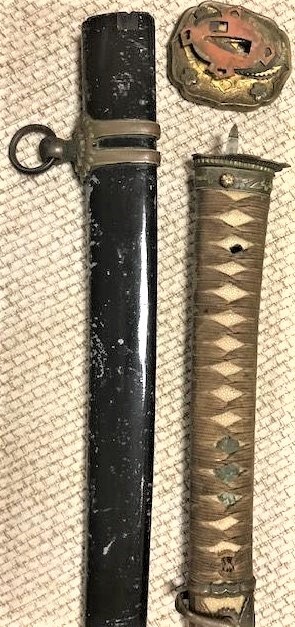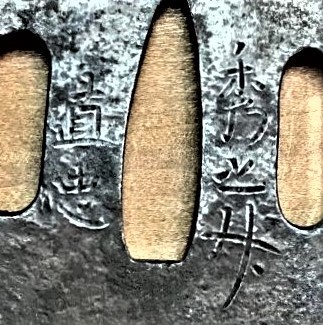-
Posts
703 -
Joined
-
Last visited
-
Days Won
4
Content Type
Profiles
Forums
Events
Store
Downloads
Gallery
Everything posted by Ron STL
-
Looking for your thoughts on these old friends of min. This very old set of menuki have long been a favorite in my collection of menuki. I Had them out again to study them and surprisingly, discovered something unnoticed before. Each animal is eating what appears to be a fish! This helps me to confirm my suspicion the critter is likely a weasel. I've known it was not a squirrel and suspected a weasel or badge, but the tail and body shape resemble more that of a weasel than a badger. Could this relate to a Japanese tale or story? I'm also looking for you opinions on where to place these menuki. Obviously, they have great age. On the backs, which have maie/female posts, you can see remnants of a silvery gold coating on them. This made me think Ezo, but the front shows nothing like this. Also, thinking Ezo one thinks large size menuki. These measure 3.6 cm. In my judgement they could date back to Ezo, at least early Muromachi or even earlier. I hope you find this an intersting pair of menuki, and can share some opinion on both the critter and age/origin of the menuki. Ron STL
-
Steve. you made this look way to simple, but thanks very much. I would have never, never figured this one out. A nice discovery, to see it gifted to the soldier heading out to war. I will actually see the sword very soon to see what quality it has, but the inscription alone will give its present-day owner much more appreciation for what "grandpa" brought back. Who knows, when he visits, he might become another collector. Again, many thanks for solving the mystery of what's on this nakago. Ron STL
-
A local guy was asking about a WWII sword his relative gave him, and he was directed to me. All I can figure out is the date, Koki 2600, but the rest I havn't a clue what it says. I tried multiple times to connect a few idea but nothing. I was about to let him know what little I can say, but thought I'd see if anyone can actually pick out the makers name. If not, I'll declare it end of story. Almost resembles a so-called Chinese knock-off, but it really was a WWII bring-back. Will pass on what can be said. I will invite him over sometime soon to introduce him to swords since he is local. Ron STL
-
No revese side image at the moment but hope to have this available again later this week. Wish me luck in acquiring it. Ron STL
-

Giving up trying to translate difficult mei.
Ron STL replied to Ron STL's topic in Translation Assistance
The pattern on the tsuba did look familar, I am unfamiliar with Seiryuken Eiju. Maybe I should be! I'll be seeing this tsuba again I'm sure and give it more attention. Not sure why the kao seems so "smeared." As you pointed out, Brian, I'll remember that pattern and Eiju should I come across it again. As always, thanks for helping when confused. Ron STL -
Have tried to break the mei on this iron tsuba, but struck out. This hiragana mei has stumped me. Any suggestions? Thanks. Ron STL
-
Mai, I've been unsuccessful finding this NMB article you mentioned above. I must be missing something as to locating this on NMB. Any help in how to find this article? Ron STL
-
Thanks for the back-up on this, Curran. I have the Gifu Museum book and love looking at the many fine examples. I'll have to check the diagram you mention to see if it explains anything to me. Your sold tsuba look gorgeous, just what I enjoy in these Momoyama era ko-kinko works. I usually see them after a dealer gets them which of course means a price rise. I do hope my friend parts with this one I pictured. I've picked out a number of equally nice later tsuba of equal value, thereabouts, but he is always afraid to part with something I say is nice. I think the nanako on your tsuba is following the shape of the tsuba where my example has vertical nanako. intresting. Ron STL
-
Studying this lovely tsuba with an eye to acquiring it. It is of shakudo and depicts butterflies, peony and plum blossoms. Notice the vertical (up and down) lines of nanako. The mimi appears to be part of the plate. Worn gold highlighting can be seen. The tsuba, I'm told, came from Dean Hartley's collection, so maybe the seller will remember it if on this group. My interest is judged by it being early work of the Momoyama period. I would appreciate having your thoughts on the tsuba. Whatever, it is worth taking a look at just to enjoy the tsuba. Ron STL
-
All very interesting information, especially the link to the earlier NMB discussion. Myself, I find it interesting to locate a picture of a smith, just for my records. Still need to check out the article mentioned on Kojima Family. Thanks guys, you always are so helpful. Ron STL
-
A friend brought this sword over during our get together last Friday. A woman gave it to him! The mei reads Noshu Seki Kanetaka (unusual three-stroke kanji, Taka). I'm wondering if any example of his work is pictured anywhere. Sesko lists him saying he died in 1963. It looks like he continued as a smith after the war. It is a very handsome sugata and has a well-made and enjoyable to study hamon. If anyone knows of a pictorial source showing his nakago, wonderful. My gendaito references are very limited. It has been left with me a while, so if a better description is needed, I'll provide that later. Ron STL
-
Thanks, that's what I needed. I've been trying to keep records of several fittings and swords in this way which should allow a relatively way to translate basic often used kanji. Easier than trying to use a dictionary, most times. Again, thanks. Ron STL
-
Thanks for your comments and I'll go with this being a more general attribution resembling calls like Kyo-sukashi and others. This would kind of explain why it was not designated Tokubetsu Hozon. Ron STL
-
Here is a shakudo sukashi tsuba, mumei, depicting the "seven sages in bamboo grove" theme. The quality is excellent with highly detailed zogan faces on each scholar. I recall showing this tsuba to John Yumoto many years ago soon after I acquired it. His comment was most likely it was made special for a patron which is why it was of shakudo, unsigned, as it is. A couple years ago I sent the tsuba for NBTHK shinsa. To my surprise it did not get Tokubetsu Hozon, possibly because it wasn't submitted (in error). My question today is about the attribution HIKONE as opposed to SOTEN. Is Hikone, "hinting" that it was made by the master tsuba-ko, opposed to a more general Soten school attribution? Does anyone have any fact-based opinion about this? I do realize that the NBTHK does have set ways about their attributions that can be understood (interpreted) more clearly, learned from experience. Your thought on this would be appreciated, as always. Ron STL
-
I have been working on translating the description of a beautiful Shakudo sukashi tsuba papered to Hikone. At this point, I have seven kanji needing translation so I can fully understand the tsuba. The missing kanji are likely common kanji for techniques used, but any help would be appreciated. I'll also post another question regarding the Hozon attribution under tosogu. Thanks, Ron STL
-
Thanks guys, not sure why I couldn't locate "sukidashi" but that makes sense. Sukidashi is used on most Naokatsu and followers tsuba, but just couldn't locate this from my records. As for the tortoise shell, I did come across the kikkogata word referring to that pattern used in designs and fabrics, but not on swords. But that must be correct and I'll include in my records for this tsuba and others with that pattern as used when copying Nobuiye tsuba. Almost a "must have" pattern on Naokatsu's copies. Interesting, so again thanks. Ron STL
-
This is a short detail I'd like to get translate. Last two kanji reads "kebori" but what are the top two kanji? Possibly referring to tortoise shell pattern? If not I'd still want to find this kanji for tortoise shell pattern as found on Nobuiie tsuba. Should know this but if so, brain dead today. Thanks Ron STL
-
I was wondering if anyone has seen any examples of saya fittings properly boxed. Photos show a set of Satsuma style saya fitting in iron with gold centipede mon and the Satsuma "cross in circle border" mon. I would love to place this set into a nice kiri wood box, but to do so would require some custom work I'm sure. I have never seen a set of saya fittings boxed before, but this must had been seen somewhere before. I'm just searching for some direction on this idea that look appropriate done, not too Americanized shall I say. Ron STL
-

Shin-gunto with black saya, any significance?
Ron STL replied to Ron STL's topic in Military Swords of Japan
All very interesting to learn about this black saya question. Answered my question. Meanwhile, Peter, I wondered if you were there to pick up on the Sendai mei. I did have fun checking out this Sednai Kanetsugu fellow but there is not a lot out there on him, although rated "Chu-Jo saku" by Fujishiro. The blade which was suriage and stained from childhood chopping stuff was still interesting. Basically a suguha hamon and original sugata of 28" + originally. you asked for the mei, so the photos should do that. No Kunekane, Peter, but they may have shared some saki together. Ron STL -
Just purchased a typical shin-gunto which has a black saya and am curious if this carries any significance. The sword has not been examined since carried in the war, but suffered typical abuse by the child that it was given to. The black saya definitely appears to be issued with this black color, something I've never encountered before. Perhaps someone who studies military mountings can comment on this for me? Surprisingly, the sword blade is a shinshin-to that has been shortened ~ 3.5" singed/dated Oshu Sendai ju Minamoto Kanetsugu, dated 1851. The tsuka was literally rusted onto the nakago, this plus suriage sort of minimizes any value in the blade. However the black painted saya might carry some significance. I'll save this for my table in Chicago in April, but would appreciate your thoughts on this saya. Ron STL
-
I am also impressed and both I and the owner thank you so very much. My guess is that this was a special tsuba, possibly by request, to carry these proverbs. Whatever, this information will become part of this tsuba's file. I'll search through my book of Nobuiye oshigata to see if by chance these proverbs might be found. The Hidesai (alternate readings) used by Naotada have not been found elsewhere, to date. Seldom see much on these lesser smiths. Not sure if it means anything but notice Naotada used the final vertical stroke in Nao which is later dropped. Again, thanks for your fine explanation of this motif. Ron STL
-
I have been studying a tsuba belonging to a friend that was made by NAOTADA, associated with shinshinto Naokatsu. As some may recall, I have been studying Naokatsu and students, both swords and tsuba. My first question is to find a translation of the complete mei. I have been unable to understand what the complete mei is. Second part of this post. The tsuba is typical of the group that copied the style of Nobuiye. Here it looks like the plate might have a series of kanji carved on it in hiragana (?). If so, does this translate into something? It is an interesting tsuba to enjoy, wish it was mine. But it is always available to study, being local. RonSTL
-
Thanks Geraint, at least that satisfies my curiosity. Curran, I'll try and get more crisp photos of the details not seen on the Iphone shots. I will say my first thoughts were, "if these were sent for shinsa" they would come back as late Edo, Kyo-kinko or something like that. What this is about, I'm considering using these for the 2022 KTK Catalog (if accepted), but lack a reliable description at this point. As you said, more crisp photography would be needed. Meanwhile, your thoughts and impressions are appreciated. RonSTL
-
This is a two-part posting so let's see what it turns up. I have a very beautiful f/k depicting "cranes" and am trying to place age/school for it. It was once owned by RB Caldwell and sold after his death. Of all the books in my library, I never did buy his book showing items from his collection. First question, if somebody out there has a copy of this book I'd appreciate looking to see if by chance, this set is pictured. If so, what is it described as. Second, I'm open to any opinion can be offered on the set. My apologies for the not so clear photo, but in reality, the detail is terrific. The wing feathers are individually detailed down to the hairs of each feather, for example. The nanako is well made and slightly large (not like Goto nanako). I'm just trying to get some direction on the set. I have some opinion, but will wait to the fresh thoughts first. It is frustrating that this seems to be the best quality my I-Phone 7 can do. The phone is do to be replaced sometime, meanwhile I need to reacquaint myself with my camera I suppose. Thanks for any help you can give me on identifying the set. RonSTL




.jpg.bdd5dadeb6b41b1d93f2073bedade408.jpg)
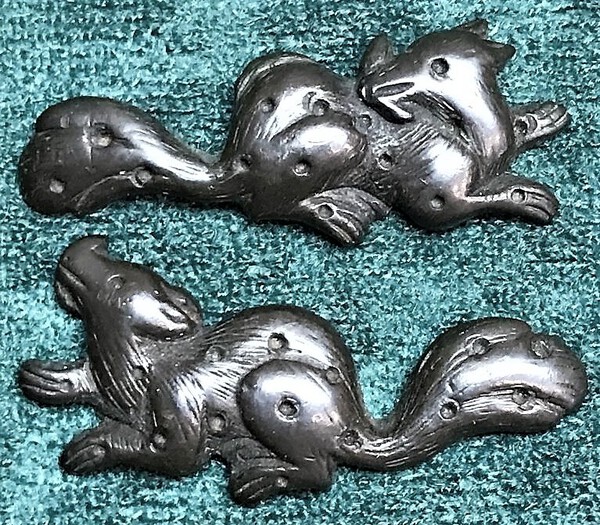
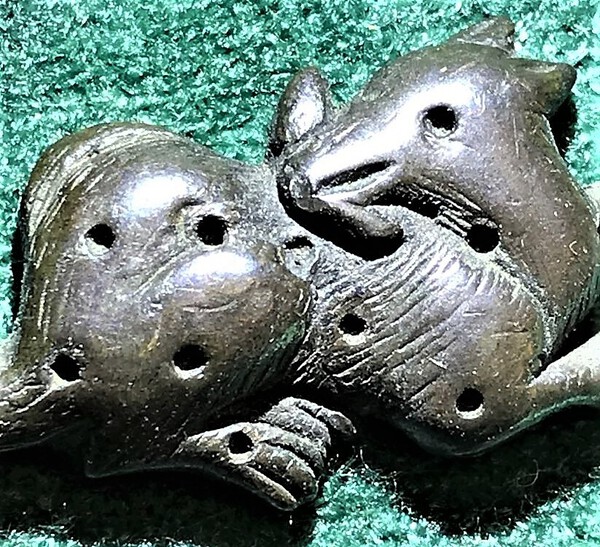
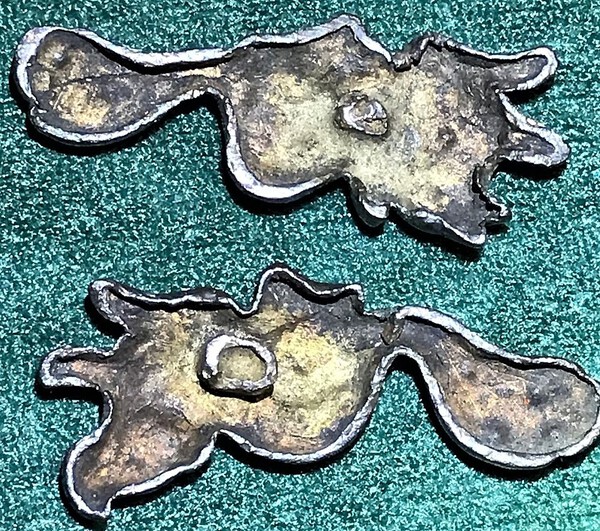
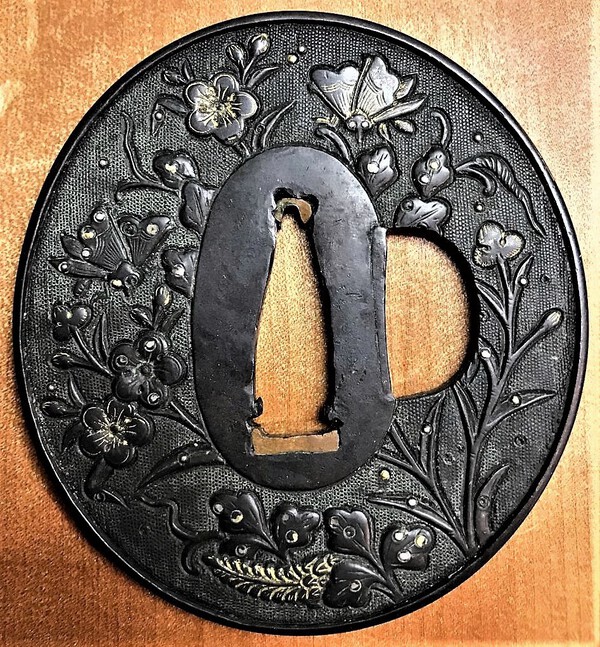





.jpg.222e0bcc8347ebb73a07e6952bfed618.jpg)












